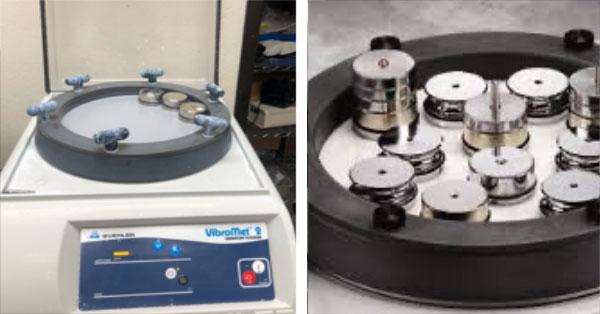
VIBRATORY POLISHING MACHINES
High Quality Vibratory Polisher—Buehler VibroMet™ 2
The Buehler VibroMet 2 vibratory polisher is unlike standard vibratory polishers. It prepares high-quality polished surfaces on a wide variety of materials, including EBSD applications. The 7200 cycles per minute horizontal motion produces a very effective polishing action that maximizes the length of time the sample is in contact with the polishing cloth. As a result, you get superior results, exceptional flatness, and less deformation.
- Fast—7200 cycles per minute
- Flexible—for use on a variety of sample materials
- Affordable—a cost-effective alternative to other sample preparation methods

Vibratory Polishing—An Affordable Alternative to Ion Beam Milling
If you would like a demo of our vibratory polishing systems, pricing, or need assistance with your sample preparation process, please use the form on this page to contact us. Or, give us a call at (408) 436-6336.
What is Vibratory Polishing?
An alternative to ion milling is vibratory polishing.
Vibratory polishing is a technique that uses a vibrating bowl to polish sample surfaces.
How is vibratory polishing performed?
Vibratory polishing typically uses a sample mounted in an epoxy “puck.” The sample is delicately polished by the horizontal motion created by the polisher.
The vibratory action produces a very flat surface with minimal surface deformation when compared to the purely mechanical polish from a polishing wheel.

Benefits of Vibratory Polishing
Vibratory polishing is a more gentle polishing technique than other mechanical polishing techniques and creates less surface damage. In addition:
- Vibratory polishers are affordable and relatively easy to set up and master. Typical vibratory polishing times run from an hour to multiple hours and the results can be stunning.
- The vibratory polishing process works exceptionally well for soft or ductile materials (lead, magnesium, aluminum, and other pure metals) where mechanical polishing can embed diamond or SiC particles into the sample, or where an ion mill can cause streaking. We call this scaling where the ion beam cuts a trench in the sample. In addition, vibratory polishers work well with delicate samples that risk delamination and cracking.
- Vibratory polishers also work well with samples that are composed of materials of differing hardnesses. Mechanical polishing methods can cause delamination, streaking/smearing, and a non-flat surface. This method will keep the sample surface flat while polishing evenly.
- Most vibratory polishers allow you to run multiple samples at once (normally up to about six) which saves process time and materials ultimately reducing consumable costs.
The best method of sample preparation is dependent on the material to be analyzed, the size of the sample, and how it is mounted.
When preparing samples for applications such as EBSD (Electron Backscatter Diffraction), it is critical to get high-quality and accurate data. Consequently, we use both vibratory polishing and ion milling equipment in our lab. Both systems are complementary where samples and polishing needs vary dramatically.






